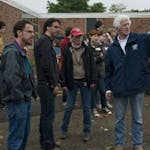Dean Devlin, director of "Geostorm," helms the outrageous horror/thriller "Bad Samaritan," starring David Tennant. The humdinger of a script by Brandon Boyce takes a play on the popular idiom and reverse-engineers the story from there. This is an audaciously wacky film, but the filmmakers do manage to get a few things just right.
Robert Sheehan stars as Sean, a plucky amateur photographer who makes extra money as a restaurant valet, where he makes even more money committing petty theft. One night, he and his friend Derek (Carlito Olivero) think they've hit the jackpot when they park the sports car of wealthy jerk Cale (Tennant). Sean discovers a woman, Katie (Kerry Condon), chained to a chair at Cale's home.
Here's where the good/bad Samaritan duality comes into play. Sean may be a thief, but he's got a titanium moral compass. He tries to save Katie with a set of bolt cutters, but he's foiled by Cale's mastery of his technologically advanced smart house. So he reports the incident to the police, the FBI, anyone he thinks might listen, even while he's being stalked and threatened by Cale.
This is suspenseful, classic horror filmmaking, with plenty of jump scares and ominous camera movements. But where the film shines is in its realistic use of technology.
Cale may have a smart house that he's learned to weaponize through surveillance cameras and lights, but Sean's got an iPhone, and he knows how to use it. And although Cale might have the money and the more advanced gear, Sean is quick on his feet, snapping FaceTime screenshots or using his camera as a periscope.
The use of technology is also what truly offers the scares in this film. "Girl-in-a-dungeon" films are a dime a dozen. But valets using GPS to rob houses? Miniature magnetic trackers? A psycho who steals your password and sends nude photos of your girlfriend to all of her Facebook friends? That's the stuff that really chills to the bone in "Bad Samaritan," which understands technology and the way that it's woven into our everyday lives, as extensions of our bodies, weapons that can be used for or against us.





